Samsung Electronics Co S760 Notebook Computer User Manual Version 0 Maverick Change from Matrix
Samsung Electronics Co Ltd Notebook Computer Version 0 Maverick Change from Matrix
Contents
- 1. user manual 1 of 3
- 2. user manual 2 of 3
- 3. user manual 3 of 3
user manual 1 of 3
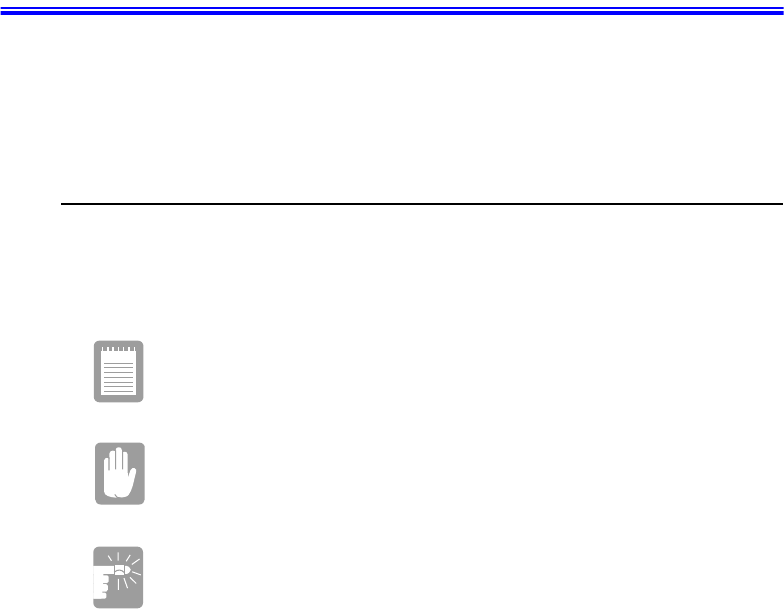
Using Your Documentation 1
Using Your Documentation
Congratulations on your purchase of a notebook computer. Whether you are new to
using a portable computer or are an experienced user, this user’s manual can help you
get the most from your computer.
Manual Documentation Conventions
Information Icons
Three icons and their associated messages appear in this manual:
A note informs you of special circumstances.
A caution warns you of possible damage to equipment or data.
A warning indicates the possibility of personal injury.
Keyboard Conventions
Keys that you need to press to perform certain functions are shown in the manual
enclosed in angle brackets. For example,
<Ctrl>
indicates the control key (Ctrl on the keyboard).
If you need to press two keys at the same time, the key names are shown joined by a
plus sign. For example,
<Alt+Pg Up>
means that you should press the Alt key and hold it and then press th e PgUp key.
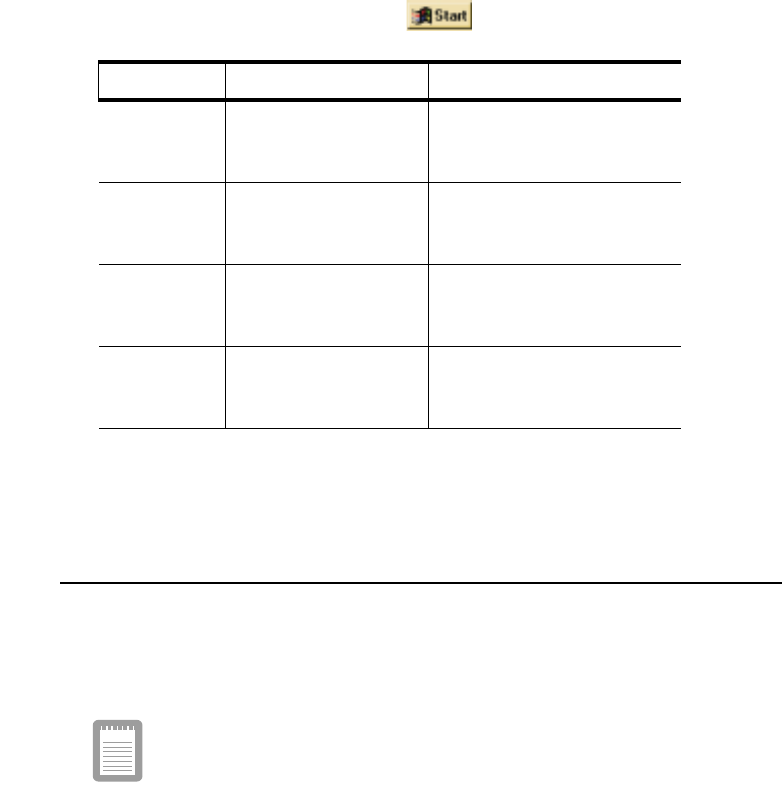
2 Using Your Documentation
Mouse/Touchpad Conventions
You may be asked to click, double click, click an hold or right click on items on the
display screen.
The object that needs to be clicked upon will be displayed in Italic text or shown in a
small figure such as the "Start Button.
If you are new to using computers, see “Glossary”. The “Glossary” explains general
computing terms that are used in this manual and tells you about some of the
differences between notebook computers and desktop computers.
Software User Documentation
Your computer is shipped from the factory with several software programs installed.
The software may include its own online or printed documentation. Refer to the
documentation or the Help options in the software for more information.
The figures and illustrations in this manual may not be identical to those
on your system.
Action Process Comment
Click Depress the mouse/
touchpad left button
and release
This will cause a process to
begin
Double Click Quickly click the left
mouse/touchpad button
two times
This will cause a process to
begin
Click-Hold Depress the mouse/
touchpad button and do
not release
This is used to move/drag
objects to new locations
Right Click Depress the mouse/
touchpad right button
and release
This is usually used to obtain
information about an object or
start a process
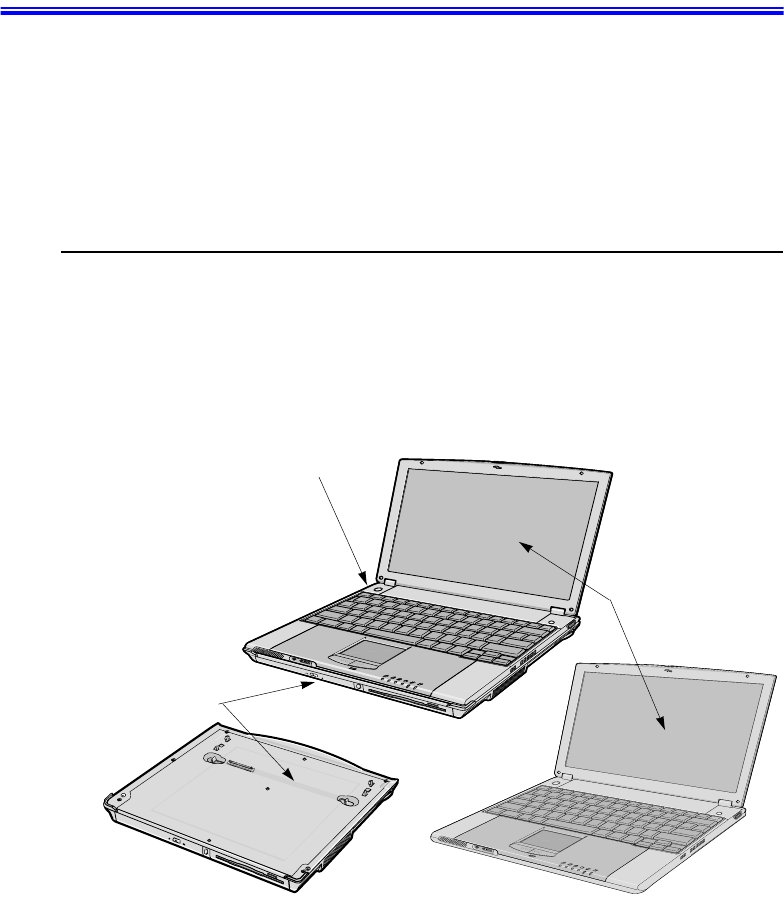
Introducing Your Computer 3
Introducing Your Computer
Your lightweight portable notebook computer includes many features to meet your
computing needs at home and/or on the road. These features are a lightweight portable
notebook computer and a docking station that contains all of the peripheral devices you
may need. Your system is very powerful and can perform all of the functions of a
desktop computer.
Where Everything Is
The following sections "PC Equipment Locations" and "Docking Bay Equipment
Locations" will explain the details of the notebook computer and the docking station
as well as other basic operations to dock and undock the computer.
You are provided with a notebook computer and its docking station (shown below) as
well as many other accessories.
Figure 1. Basic System
Docking Station
Notebook Computer
Notebook & Docking Station
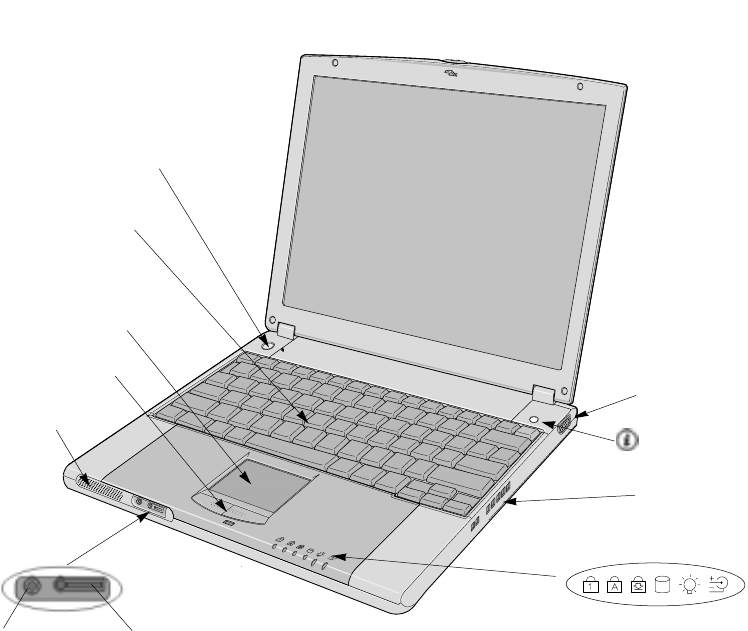
4 Introducing Your Computer
PC Equipment Location
The figures in this section show you the location of important items on the computer.
Figure 2. Front View of PC
Internet Key
LED’s
Touchpad
Speaker
Microphone Jack Headphone Jack/MP3 Remote Controller Jack
Touchpad Buttons
Keyboard
Power Button
LCD Display
Fan Vent
Video Port
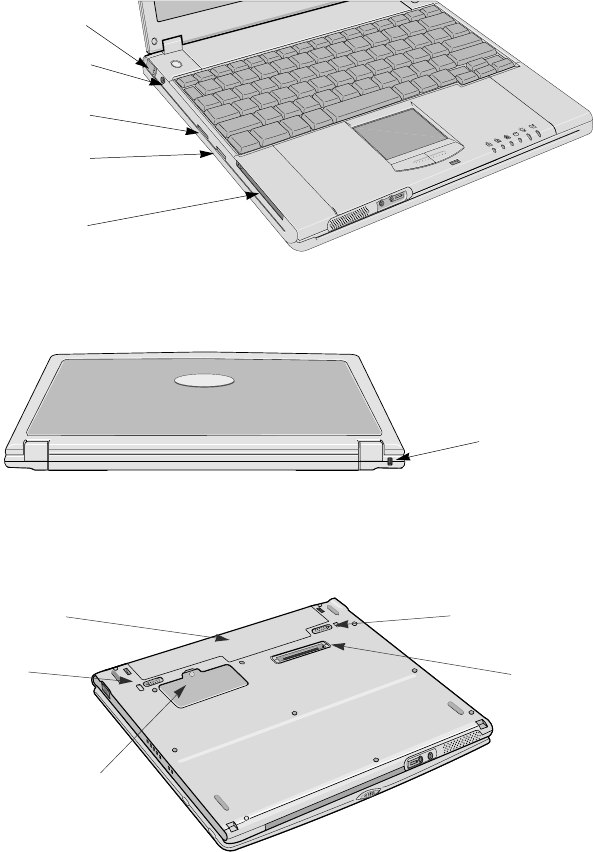
Introducing Your Computer 5
Figure 3. Left View of PC
Figure 4. Back View of PC
The figure below is the bottom view of the PC without the Docking Station attached.
See ”Using the Multi-Bay Docking Station” on page 30.
Figure 5. Bottom View of PC
USB Port
DC-in Port
PC Card Slot
LAN/Serial Port
Modem Port
Kensington Lock
Battery Compartment
Battery Latch
Memory Module Compartment
Docking Connector
Battery Latch
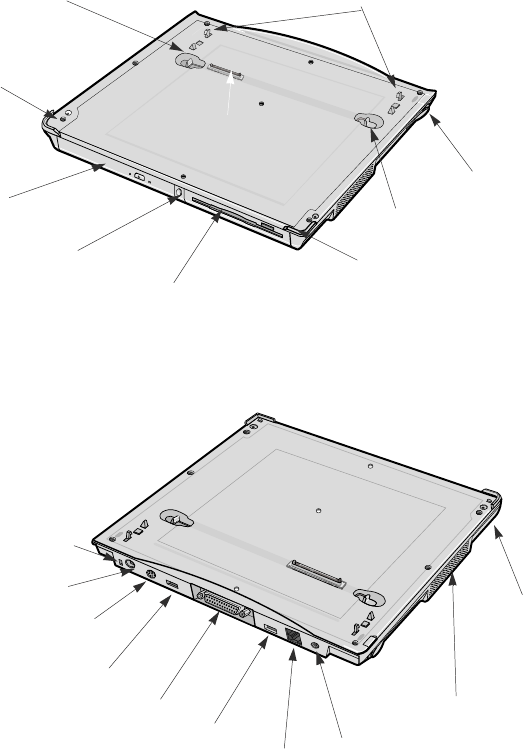
6 Introducing Your Computer
Docking Bay Equipment Location
The figures in this section show you the location of important items on the docking
station.
Figure 6. Docking Station Front/Top
Figure 7. Docking Station Back
Docking Release Latch
Docking Pins
FDD Release Latch
CD/DVD Release Latch
Docking Connector
Undocking Button
Docking Hook
CD/DVD Drive
FDD [Floppy Disk Drive]
Docking Hook
Kensington Lock
TV-Out Port
PS/2 Port
USB Port
USB Port
LAN Port DC-in Port
Speaker
DockingRelease
Latch
Printer Port
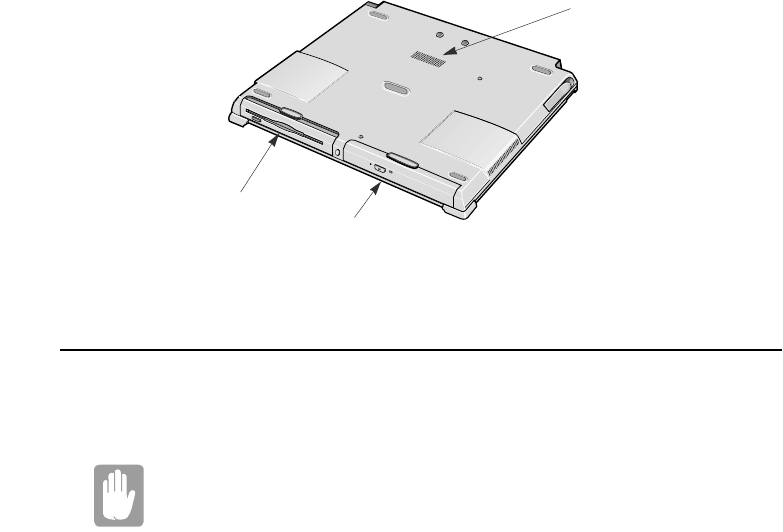
Introducing Your Computer 7
Figure 8. Docking Station Bottom
Undocking/Docking your Computer
The docking station allows you to use this system as a desktop PC. The docking station
is installed to the system at the point of purchase.
Connect the AC adapter to a docking when it is installed to a system.
Undocking your Computer
Power Off
To remove your computer from the docking station with the power off, complete the
following steps.
1. Turn off the system.
2. Disconnect the AC adapter.
Speaker
FDD Drive
CD/DVD Drive
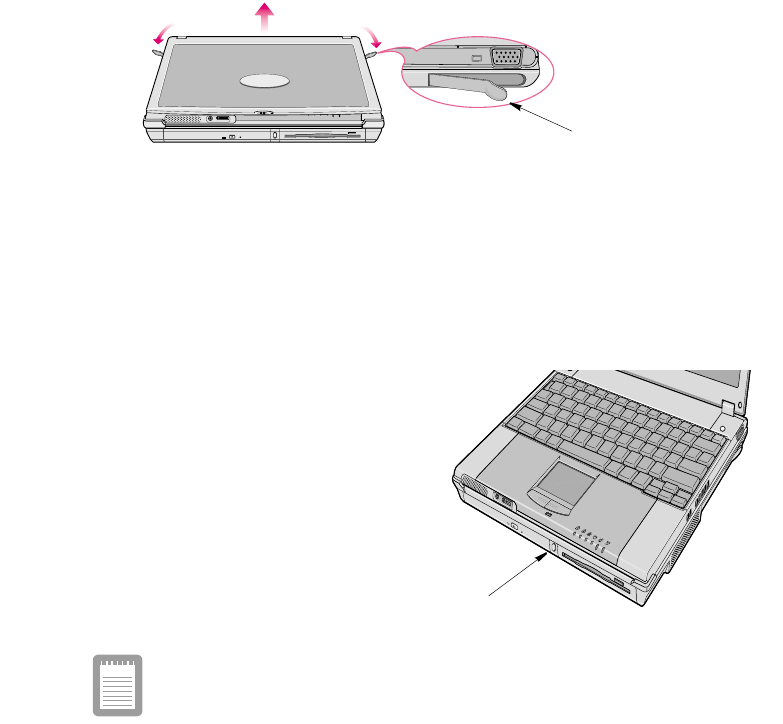
8 Introducing Your Computer
3. Grab the two docking release latches and pull them out.
Figure 9. Release Latch
4. Tilt the system up at the back.
5. After tilting remove the system by sliding/lifting out toward the back of the docking
bay.
6. Connect the AC adapter to the system.
Power On.
1. Press the PC detach button on front
of the docking.
2. When [xxxx] message shows on the
screen, then hold and pull two
release latches.
3. Remove a system.
4. Attach the AC adapter to a system.
UseStart>PCdetachinsteadofthePCdetachbutton.
Docking your Computer
Power Off
To install your computer into the docking station with the power off complete the
following steps.
1. Disconnect the AC adapter from the system.
Release Latch
PC Detach Button
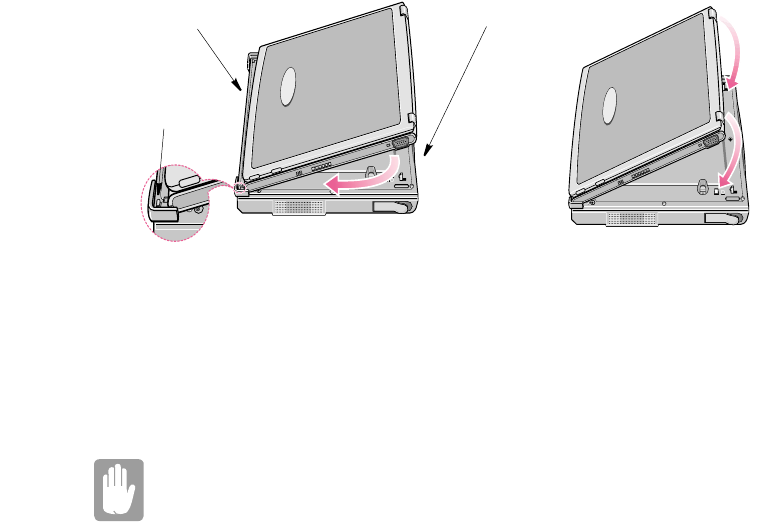
Introducing Your Computer 9
2. Place the front part of a system on two hooks of the docking station.
Figure 10. Docking Sequence
3. Press the back part of a system until it clicks into a docking fully.
Power on
To dock your computer with the power on just reverse the directions in the power on
undocking section.
When it is connected properly then [xxxxx] message shows. Press a
system to make sure that a docking connector is completely connected
to the system.
Back of the System Front of the System
Hook
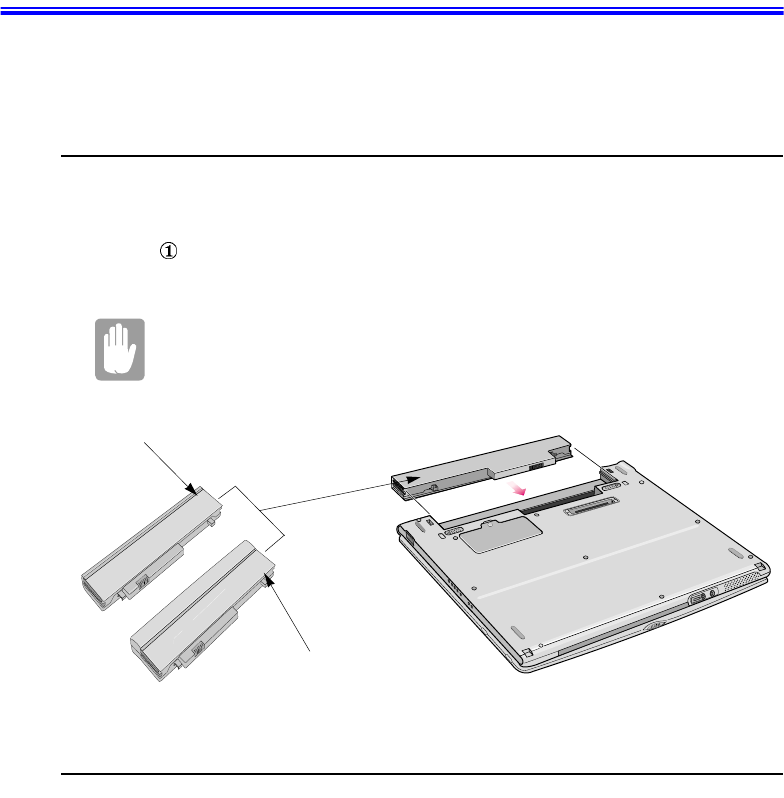
10 Using Your Computer for the First Time
Using Your Computer for the First Time
This section gives you detailed information on using your computer for the first time.
Installing the Battery
The first step in using your notebook computer is to determine the normal use for your
computer. Two batteries come with the computer and both go into the same slot.
Battery may be used wether the computer is in the docking station or not. Battery 2
may only be used when the PC is not in the docking station.
Ensure that both battery latches are slid fully toward the center of the
computer.
AC Adapter
Your computer runs on power from the battery in the computer or from an electrical
outlet. The first time that you use your computer, fully charge the battery by attaching
the power cord to the computer and to an electrical outlet.
1
2
Battery for PC Alone
Battery for PC & Docking Station
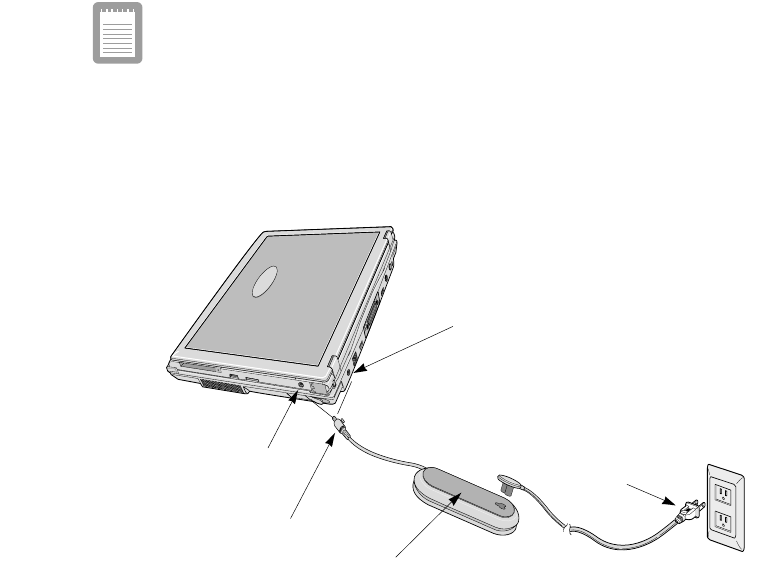
Using Your Computer for the First Time 11
All batteries lose their charge if they sit unused for an extended time
period. When not used, battery can discharge fully in 2 to 3 months.
To attach the power cord:
1. Plug the AC adapter into the power connector on the back side of the computer.
2. Connect the power cord to the AC adapter and then to an electrical outlet.
Figure 11. Connecting the AC Adapter
The battery starts charging as soon as you plug the power cord into an electrical outlet.
The battery charges faster if the computer is turned off during charging.
If the battery is fully depleted and the computer is turned off, the battery charges in
about 3 hours. If the computer is turned on, the battery charges in about 5 hours. When
the battery is charging, the battery charge light is amber. When the battery is fully
charged, the light turns green.
See ”Using the Battery” on page 44 for more information on using your computer’s
battery.
Power Connector
Power Cord
AC Adapter
PC Plug-in Port
Docking Station Plug-in Port
Plug Power Connector into either Port
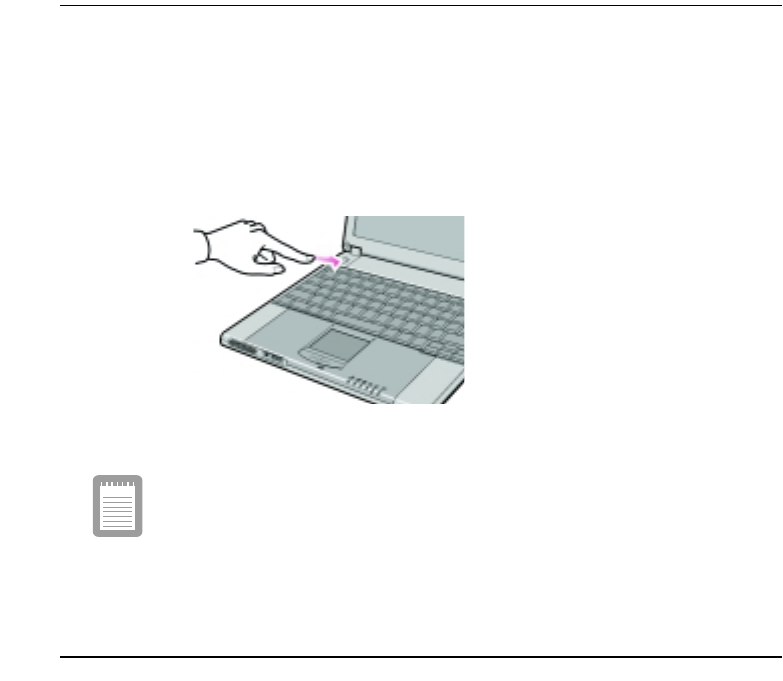
12 Using Your Computer for the First Time
TurningOntheComputer
To turn on the computer’s power for the first time:
1. Slide the LCD display or cover latch, located on the front of the cover to the right.
2. Lift up the cover.
3. Press and then release the power button (Figure 12).
The power light is on when the computer’s power is on.
Figure 12. Turning On the Computer’s Power
Initial computer startup
The first time you start your computer you will see a registration screen. There
are several screen in the registration process. Simply read each screen and
follow the simple directions. You must complete this process in order to use
your computer. A tutorial is provided if you require it.
Understanding POST
When you turn on your computer, a routine called POST (Power-On Self-Test)
automatically runs to test the computer components. Several messages appear on the
screen during POST.
Screen messages are built into the computer to report both normal and abnormal
system conditions. If an error message appears, take any action suggested in the
message. If the message identifies the error condition but does not suggest any
corrective action, write down the message and contact manufacturer or an authorized
service center for assistance. (See ”Troubleshooting” on page 111.)
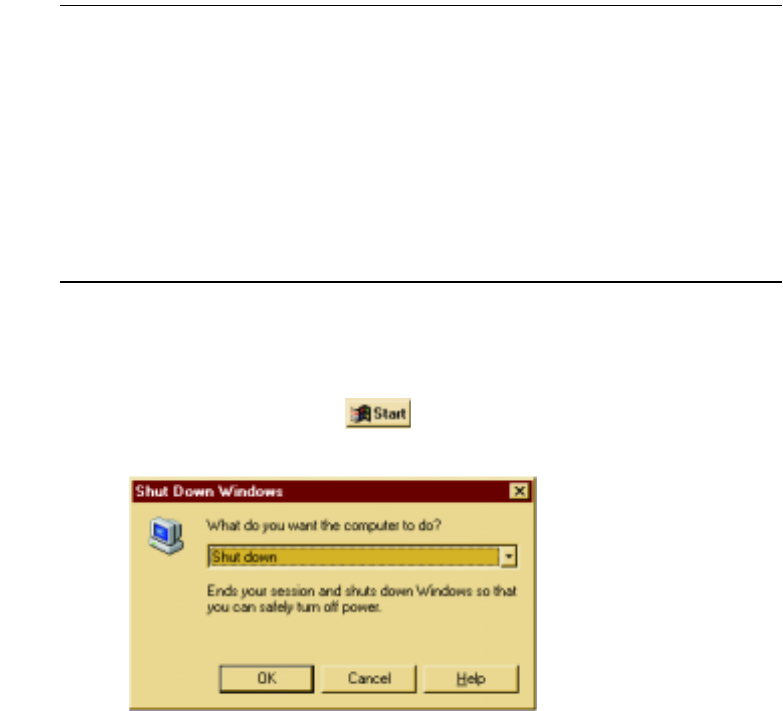
Using Your Computer for the First Time 13
Adjusting the LCD Display
You may wish to adjust the LCD (Liquid-Crystal Display) when you begin using your
computer. A TFT (Thin-Film Transistor) LCD does not require adjustment for contrast
because the contrast is set to remain at maximum.
To adjust the LCD:
•Press <Fn+F10> to decrease the display brightness.
•Press <Fn+F11> to increase the display brightness.
Turning Off Your Computer
APM (Advanced Power Management) Mode
To turn off the computer:
1. Click Start on the taskbar.
2. Click Shut Down.
3. Select the shut down option.
4. Click OK or Yes.
•If the operating system is Windows 98/2000/Me, the computer turns off.
ACPI (Advanced Configuration and Power Interface) Mode
Your computer supports ACPI mode. If your operating system supports ACPI and you
want to shut down the computer just by pressing the power button, then follow next
steps to set the menu in Power Management Properties. Also see “Using Power

14 Using Your Computer for the First Time
Management Options @” on page 89 and the documentation accompanying your
operating system.
To set the menu;
1. Select Power Options in Control Panel.
2. Select the operations of power button.
•Standby mode: operates as Save to RAM mode. (See”Suspend Mode @” on
page 90 for more information.)
•Hibernate mode: operates as Save To Disk mode. Set Hibernate submenu to
enabled to use Hibernate mode. (See ”Suspend Mode” on page 86 for more
information.)
If the system does not power off, then press and hold the power button
for over 4 seconds.
Restarting Your Computer
You may need to restart (reboot) your computer when installing hardware or software
or if the computer does not respond to your input. A warm (or soft) boot prompts you
to save your files, turns off the computer, and then restarts the computer. A cold boot
turns off the computer without saving your files.
To perform a warm (or soft) boot:
1. Click Start on the taskbar.
2. Click Shut Down.
3. Select the restart option.
4. Click OK or Yes.
5. Save your files if prompted. Your computer reboots.
Cold Boot:
Do not perform a cold boot unless your keyboard and touchpad have no effect
and you cannot perform a warm boot.
When you perform a cold boot, you lose data unless it was saved to a storage
medium.

Using Your Computer for the First Time 15
You can also perform a soft boot by saving your files and pressing <Ctrl+Alt+Del>.
You can perform a cold (or hard) boot by pressing the power button to turn the
computer off, waiting five seconds, and then pressing the power button to turn the
computer on.
Tips for Using Your Computer
The following information helps you avoid potential problems as you use your
computer:
Do not try to disassemble your computer. Opening the system chassis
voids your warranty. Only an authorized manufacturer service center
can replace or add any parts inside the chassis.
•Follow all the instructions and cautions in your computer user documentation.
•The LCD display has a polarized surface and can be damaged easily. To prevent
damage, avoid touching the screen.
•Use only approved AC adapters, auto adapters, memory modules and other options.
•Because a notebook computer is small and has restricted air flow around
components, it is more likely to overheat than a desktop computer. A fan inside
your computer runs when needed to help eliminate heat. Make sure the fan vent on
the right side of your computer is not blocked when you use the computer. (See
Figure 2 on page 4 for the location of the vent.) Occasionally check the vents and
remove any accumulated dust on the outside.
•Avoid using or storing the computer in extremely hot or cold areas, such as a car on
a hot day. Keep the computer away from heaters and out of direct sunlight.
Exposure to excessive heat may damage computer components.
If you have left your computer in a hot place, let it cool down slowly to room
temperature (with the LCD panel open) before using it.
•Do not remove the memory-module compartment door, or try to install a memory
module when the computer is on. (See ”Bottom View of PC” on page 5 for the
location of the door.)
(For information on installing memory modules, see “Installing a Memory
Module” on page 113.)
•Set up your computer work area to avoid physical strain. Sit with your back straight
and supported by your chair. Adjust your chair or work table so that your arms and
wrists can remain in a relaxed position, parallel with the floor. Avoid bending or

16 Using Your Computer for the First Time
twisting your wrists as you work. Your hands should “float” slightly above the
keyboard. Refer to a book on office ergonomics for more information on setting up
your work area.
•Take frequent breaks from working at the computer to rest your eyes and stretch
your muscles.
•Remember to save your data files frequently and to make backup copies of your
files.
Travelling with Your Computer
Air Travel
If you are travelling by air, follow these tips:
•Take the computer with you as carry-on luggage. Do not check the computer with
your baggage.
•Allow the computer and disks to go through the X-ray security devices. Do not
hand-carry disks through the walk-through metal detectors, which can cause loss of
data.
•Make sure that the battery is charged or the power cord is easily accessible. You
may be required to turn on the computer for airport security personnel.
•Be prepared to turn off the computer during take off and landing.
Locking your Computer
As a precaution when you are travelling you should keep your computer as safe as
possible. An option to do this is the Kensington Lock. You may also lock your
computer inside a briefcase but it is difficult to use. Follow the Kensington Lock
manufacturers instructions for specific installation and use.The following figures
show generally how to use the lock.
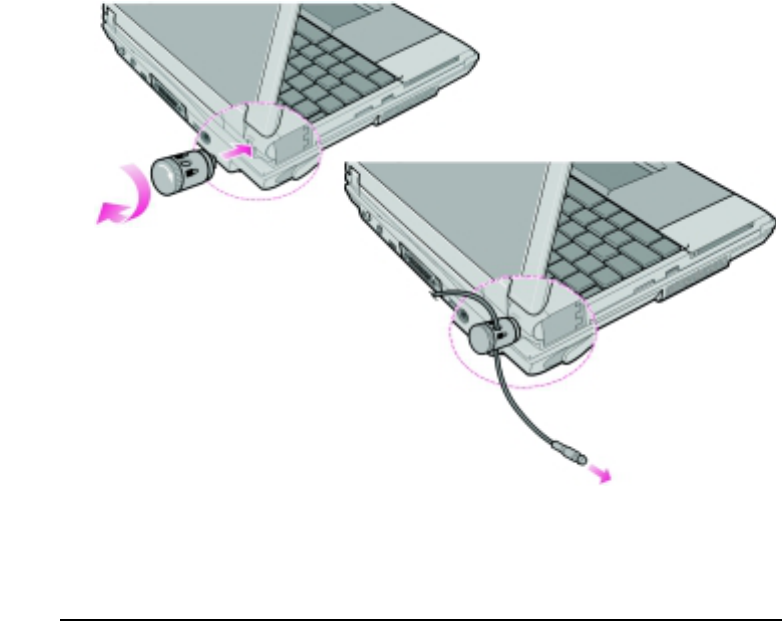
Using Your Computer for the First Time 17
Figure 13. Kensington Lock
Handling Spills
Do not spill anything on your computer. The best way to avoid spills is to avoid eating
and drinking around your computer. If you do spill something on your computer, turn
off your computer, unplug it immediately, and do the following:
•If you spill liquid on the keyboard, drain as much of the liquid from the keyboard as
possible. Be careful not to let the liquid drip onto the LCD panel. Allow the system
to dry for several days before trying to use it.
•If you spill liquid on an external keyboard or keypad, unplug it and drain as much of
the liquid as possible. Allow the keyboard to sit at room temperature for a full day
before trying to use it.

18 Using Your Computer for the First Time
Sweet liquids leave a sticky residue that may jam the keyboard despite
your efforts to dry it.
•If you spill liquid on the LCD panel, clean it immediately with a soft cloth and
denatured alcohol. Do not use water, window cleaner, acetone, aromatic solvent, or
dry, rough towels to clean it.
Some liquids damage the polarized LCD screen. If your screen is
damaged, contact your authorized manufacturer’s service center for a
replacement.
Storing the Computer for Long Periods
If possible, leave the power cord connected to the computer and an electrical outlet
when the computer is not in use. This extends the life of the battery and keeps the
battery fully charged.
If you will not be using the computer for a long period of time (a month or more), you
should completely charge the battery. After you have done so, remove the battery from
the unit.
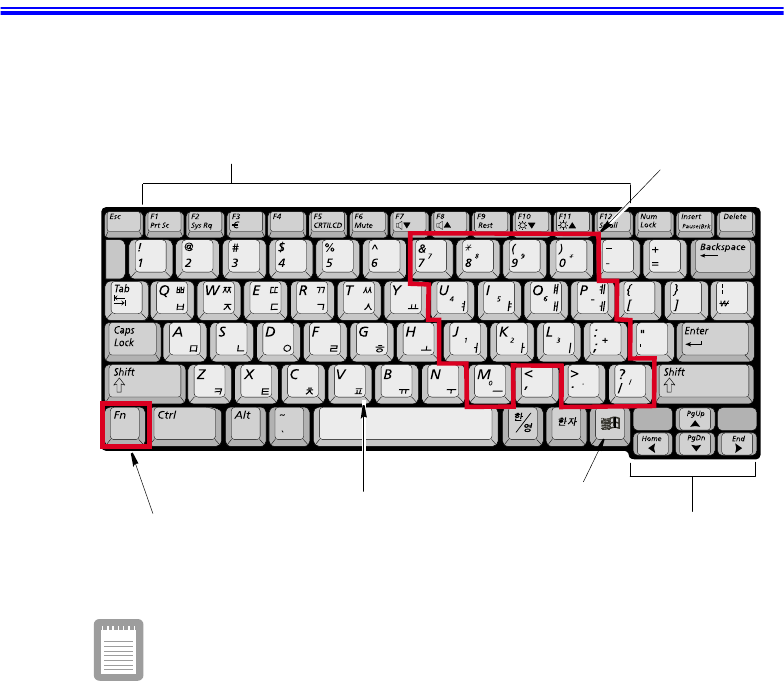
Using the Keyboard 19
Using the Keyboard
Your computer has an 87/88-key keyboard (Figure 14). By pressing designated key
combinations, you can have access to all the key functions of a full-sized keyboard.
Figure 14. Keyboard
Although the layout of the keys on your computer’s keyboard is different
from that on a desktop computer’s keyboard, the keyboard feels like a
full-sized keyboard when you use it.
The keys on the keyboard can be grouped into the following categories:
•Full-sized Alphanumeric typewriter keys are arranged like a standard typewriter
keyboard [QWERTY] and are used for text entry. The Windows key on the right
side of the spacebar open Windows menus and perform other special functions.
•Function keys, when pressed together with the <Fn> key, enable special functions.
•Cursor and Screen control keys move the cursor. They may perform other
functions, depending on your software.
Function & Special purpose Hot Keys Embedded Numeric Keypad
Alphanumeric Keys
Function Key Cursor & Screen Control Keys
Windows Key
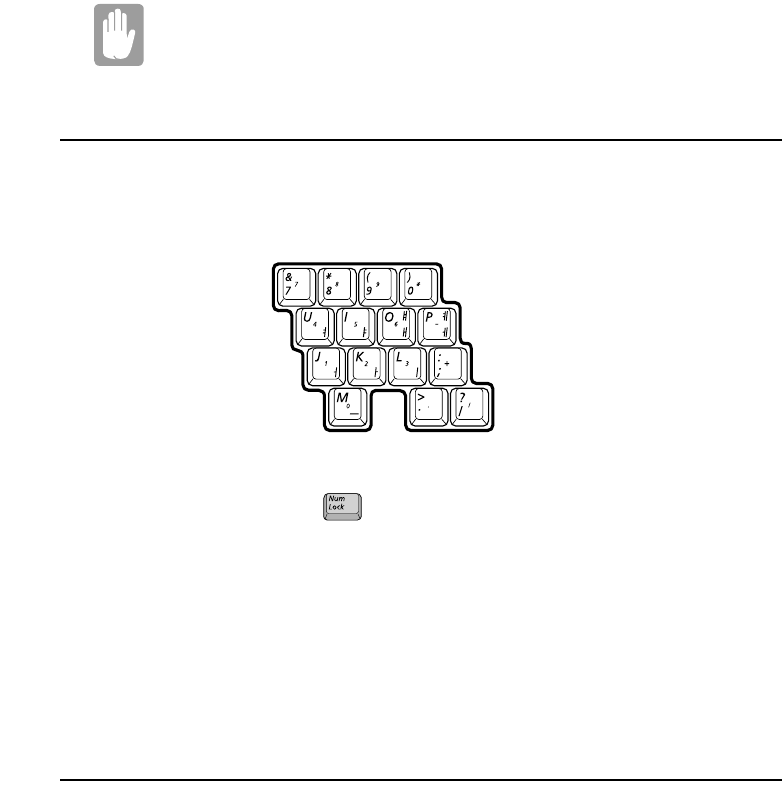
20 Using the Keyboard
To clean the computer keyboard, use slightly damp cotton swabs. Scrub the keys and
the surface around the keys.
Do not allow liquid to drip into the keyboard or you may damage the
keyboard.
Using the Numeric Keypad
Your keyboard includes a numeric keypad, which is a group of keys that you can set to
type numbers and mathematical symbols, such as the plus sign (Figure 15). A number
or symbol on the right corner of each keypad key shows its numeric function.
Figure 15. Numeric Keypad
Press the <Num Lock> key to turn on the embedded numeric keypad. The
numeric functions of the keypad are enabled and the Num Lock light turns on. (See
”System Status Lights” on page 25 for the location of the Num Lock light.)
While the numeric functions are enabled, you can temporarily return a key to its normal
function by pressing <Fn> and the key. For example to type the letter m, press
<Fn+m>.
To turn the numeric keypad off, press <Num Lock> again. The Num Lock light turns
off.
Using Special Function Keys
The <Fn> key activates special functions when it is pressed in combination with
another key. Table 1 shows the special key combinations.
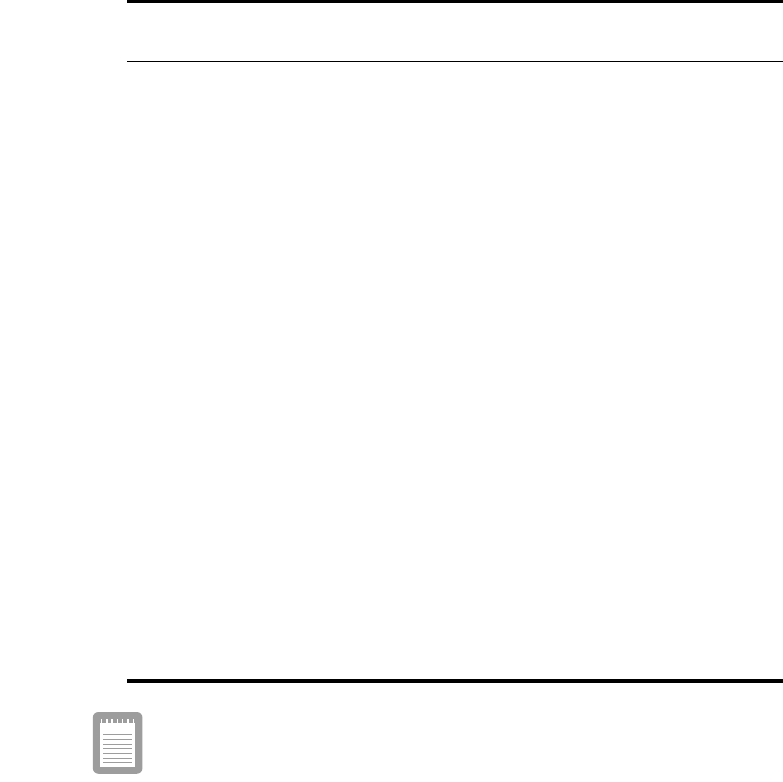
Using the Keyboard 21
Table 1. Description of Special Function Keys
When you press a function key combination, the system sound may be
temporarily muted.
<Fn> Key
Combination Function
<Fn+F1>
Print screen:
Takes a picture of the open screen, which you can paste into
the Paint program.
<Fn+F2>
System request:
Reserved for use in software programs.
<Fn+F3> This key combination can generate Euro Mark as other Eurokey.
<Fn+F5>
CRT/LCD:
Switches the display between the LCD, the external monitor,
and simultaneous display on both the LCD and the external monitor.
<Fn+F6>
Mute:
Turns the audio output on and off.
<Fn+F7>
Volume down:
Decreases the audio volume.
<Fn+F8>
Volume up:
Increases the audio volume.
<Fn+F9>
Rest:
Puts the computer into Suspend mode. To resume normal operation
from rest, press the power button. (See ”Using Power Management
Options @” on page 89 for more information about the rest mode.)
<Fn+F10>
Brightness down:
Decreases the LCD brightness.
<Fn+F11>
Brightness up:
Increases the LCD brightness.
<Fn+F12>
Scroll:
In some applications, sets the cursor-control keys to scroll the page
up or down while the cursor position does not change. Pressing
<Fn+F12> again turns off the scrolling function.
<Fn+Left
Arrow>
Home:
In some applications, moves cursor to the start of the line.
<Fn+Up
Arrow>
PgUp:
In some applications, moves cursor up one screen, not necessarily
a full page.
<Fn+Down
Arrow>
PgDn:
In some applications, moves cursor down one screen, not
necessarily a full page.
<Fn+Right
Arrow>
End:
In some applications, moves cursor to the end of the line.
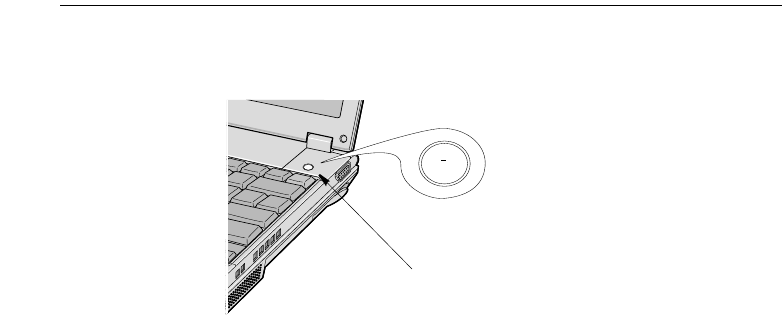
22 Using the Keyboard
Internet Explorer Quick Start Button
Use the internet quick start button to start "Internet Explorer" just by pressing one
button.
Figure 16. Internet Explorer Quick Start Button
i
Internet Explorer
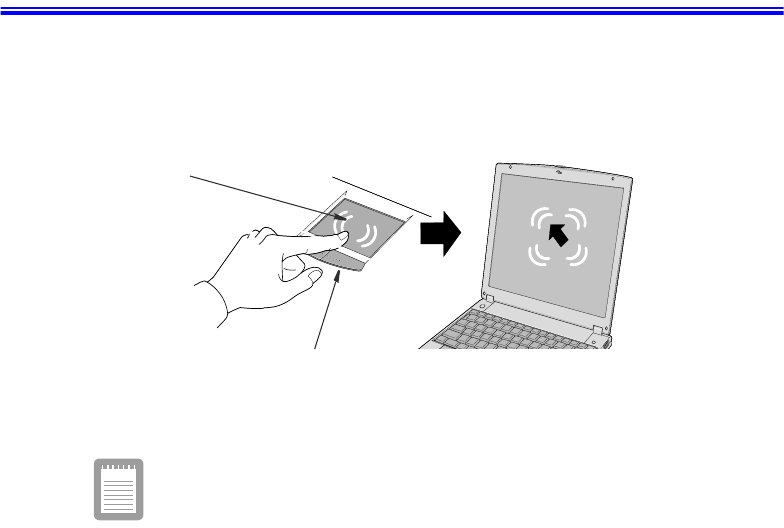
Using the Touchpad 23
Using the Touchpad
Your computer is equipped with a touchpad, which is an integrated-pointing device
that is used to perform standard mouse functions (Figure 17). The touchpad is an
advanced and reliable pointing device that works with a touch of your finger.
Figure 17. Touchpad Operation
Press on the touchpad gently. The touchpad responds to light pressure.
The following sections will basically explain how to use the touchpad.
Double Click/Tap
Select the window by tapping once on a touchpad. You can maximize the window by
double tapping the touch pad quickly or you can use the touchpad buttons.
Drag (Move)
1. Click on the window which you want to drag using the touchpad,
2. Press the left touchpad button and hold it,
3. Drag the window using the touchpad.
Mouse buttons
Touchpad
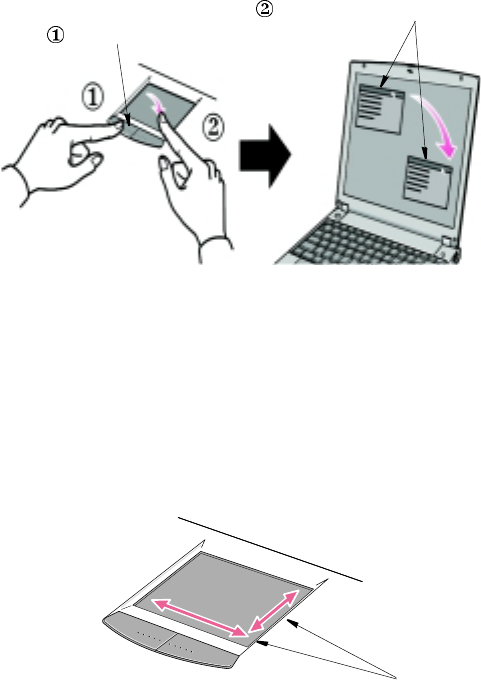
24 Using the Touchpad
Figure 18. Dragging a window
Scroll
Touchpad has a scroll function while you are exploring internet.
Scroll along the right edge of the touchpad to scroll up and down. Scroll along the
bottom edge of the touchpad to scroll right and left. However, this function may not
work in certain programs.
Figure 19. Scrolling using the touchpad
You can use the buttons below the touchpad in the same way you would use standard
mouse buttons. For more information on these features and other features supported by
your mouse driver such as button assignment, see the Mouse properties in the Control
Panel.
For information on attaching and using another pointing device or keyboard with your
computer, see “Connecting Peripheral Devices/Cables” on page 26.
Click in the window title bar to move the window
Click and Hold
Scroll Directions
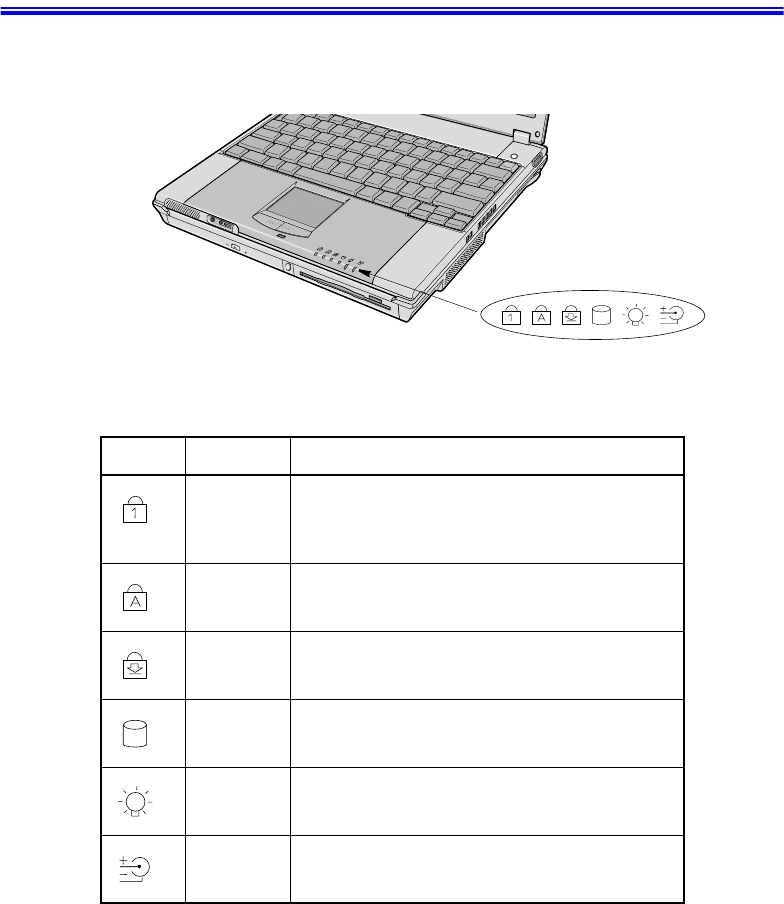
Reading the System Status Lights 25
Reading the System Status Lights
System Status lights show the status of computer functions.
Figure 20. System Status Lights
The table below describes the meaning of each status light
LED Name Function
Num Lock Changes a portion of the keyboard to a numeric
keypad.
add cross reference
Caps Lock Changes all alpha or letter input into capital letters.
No changes occur to numeric and special keys.
Scroll Lock Scroll lock in certain software
Device Light Green-UsingHarddisk
Note: There is a light inside the FDD that is on when
the disk is being accessed, you must look closely.
Power Light Green - System power on
Blinking - Low battery
Battery Light Green - No battery pack installed/battery fully charged
Amber - Charging
LEDs
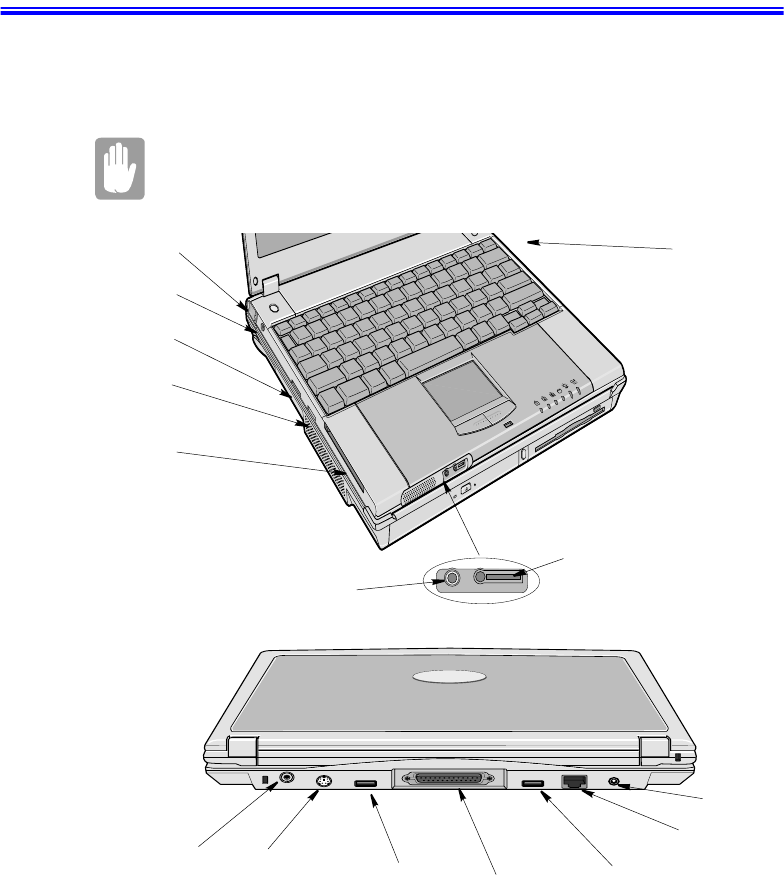
26 Connecting Peripheral Devices/Cables
Connecting Peripheral Devices/Cables
The connectors on your computer enable you to attach peripheral devices to the
computer (Figure 21).
Turn off your computer before you connect a peripheral device.
Connecting a peripheral device with your computer turned on may seriously
damage the device or your computer.
Figure 21. Peripheral Connectors
Headphone jack
Headphone Jack/
MP3 Remote Controller Jack
Video Port
on right side
USB Port
DC-in Port
PC Card Slot
LAN/Serial Port
Modem Port
Printer Port USB PortUSB Port
TV Out Port LAN Port
PS/2™ mouse &
keyboard port
DC-in Port
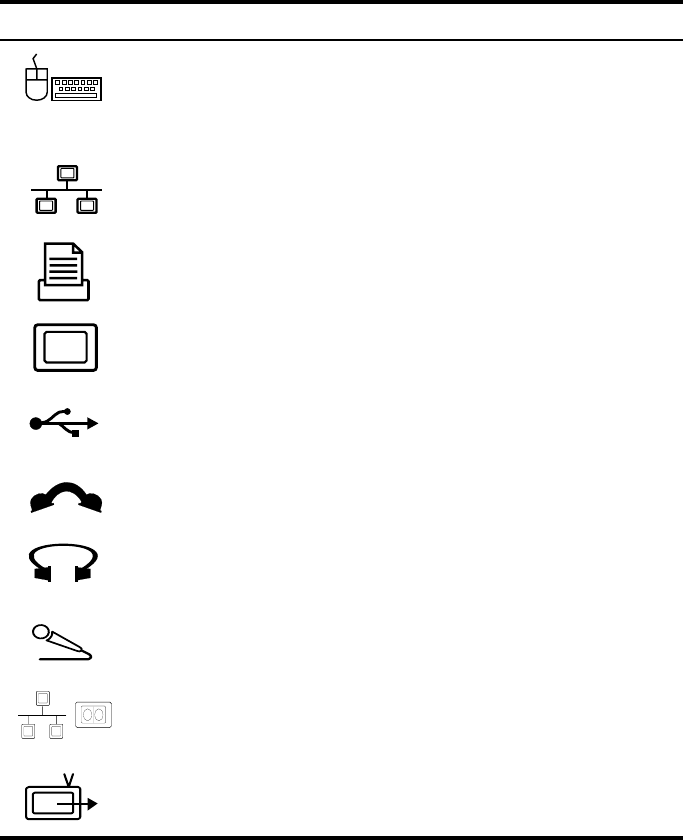
Connecting Peripheral Devices/Cables 27
Table 2 shows the icons located near each connector and tells you the devices that you
canattachtotheconnectors.
Table 2. Connecting Peripheral Devices
If your computer’s operating system is Windows 98/2000/Me, you can enable and use
the USB port.
Icon Connector
PS/2 (IBM Personal System/2) mouse and keyboard port:
Connect a PS/2-
compatible mouse or external keyboard or keypad to this port. Make sure
your computer is turned off when you attach peripherals to the port.
You can use the computer’s touchpad and a PS/2 keyboard at the same
time, See ”Advanced Menu” on page 76 for more information.
LAN port:
Connect a LAN cable to connect to internet.
Parallel port:
Plug a parallel device, such as a parallel printer this 25-pin
port.
Video port:
Plug the interface cable of an external monitor into this 15-pin
connector and then plug the monitor power cord into a grounded outlet.
USB (universal serial bus) port:
Connect USB devices to this port. USB
devices include keyboards, pointing devices, and monitors.
Modem jack:
Connect a telephone line to connect to the internet or send/
receive faxes, see the modem user’s manual for more information
Headphone jack:
Connect the MP3 player and headphones.
Microphone jack:
Connect an external microphone to this jack.A
microphone connected to this jack overrides the internal microphone.
LAN/Serial Port:
plug a LAN or Serial adapter cable into this port. Each
cable has a different function.
TV-out port:
plug a phono to scart cable into this port and the other end of
the cable into an external TV. No audio is transmitted via this port.
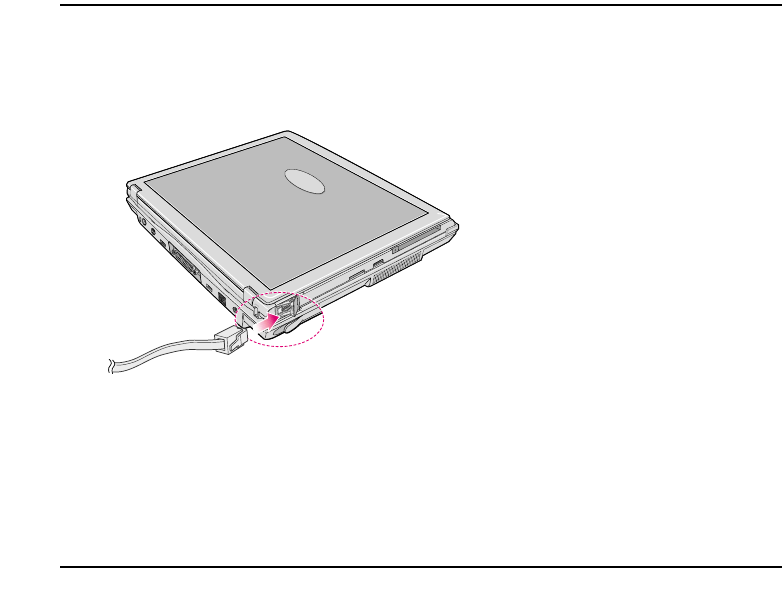
28 Connecting Peripheral Devices/Cables
Installing a Modem Cable
Before you can obtain information on the Internet or send e-mail you must install the
modem drivers and install the modem cable, see “Using the Modem” on page 51.
To install the cable. follow the steps below:
Figure 22. Modem Cable Installation
1. Open the modem cable door located in the back left portion of the computer.
2. Plug the modem cable into the slot.
Installing a LAN Cable
Before you can obtain information on the Internet, send e-mail or transfer files to or
from another computer you must install the LAN drivers,see “Using the LAN” on page
66 and install the LAN cable. There are two ways to hook up to a LAN. You may plug
directly into the back of the computer or use a LAN cable adapter.
To install the LAN cable to the back of the computer simply plug in the cable in the
slot in the back of the computer or you may also use the LAN adapter cable to access
the LAN. Simply plug the adapter cable into the LAN/Serial slot on the left side of the
computer.
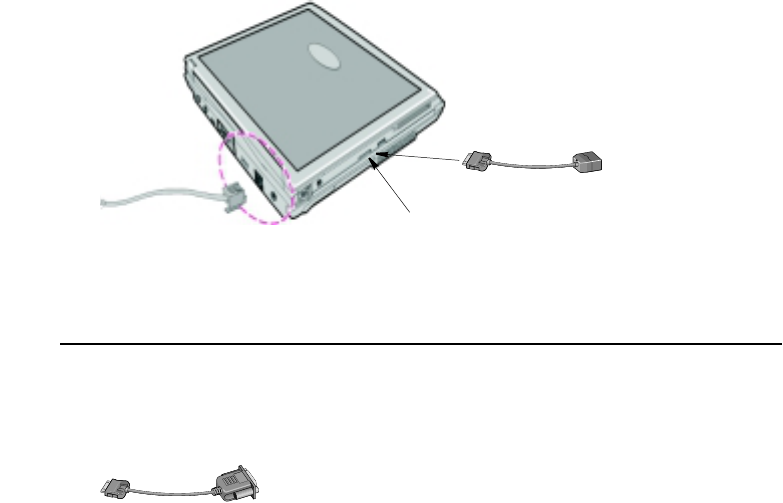
Connecting Peripheral Devices/Cables 29
Figure 23. LAN Cable Installation (Back/Left)
AT (Serial) Device Cable
The LAN/Serial port allow the use of serial devices such as a serial mouse. To install
the Serial adapter simplyplug the adapter cable into the LAN/Serial slot on the left side
of the computer. See Figure 23. on page 29
Figure 24. AT Serial Cable
LAN/Serial Port
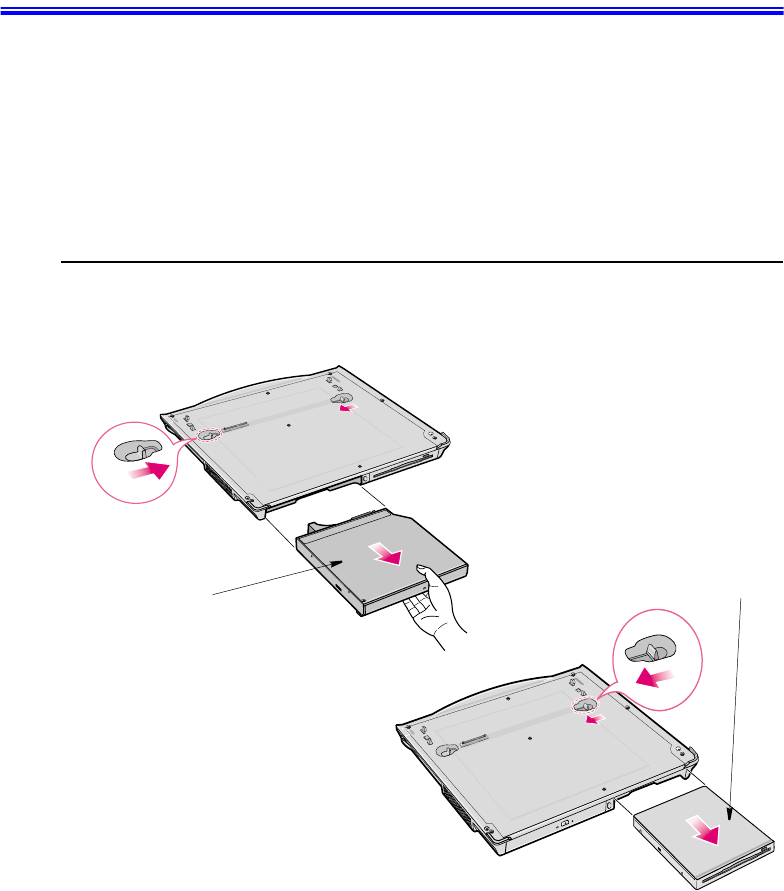
30 Using the Multi-Bay Docking Station
Using the Multi-Bay Docking Station
Your computer includes the Multi-Bay docking station that holds a 5.25" and a 3.5"
device. Below is a listing of the device types you may install in your docking bay.
5.25” Drives CD-ROM DVD-ROM CD-RW
3.50” Drives Zip drive 2nd HDD
Changing Devices
This section will discuss changing 5.25" and 3.5" devices.
The docking bay is the portion of the docking station where you change devices.,
Figure 25. Changing Devices
3.5" Device
5.25" Device
Using the Multi-Bay Docking Station 31
Changing a 5.25” Device
To change from one 5.25” device to another simply follow the steps below (Figure 25).
1. Turn off the system,
2. Detach the system from the docking station,
3. Slide the 5.25” bay latch toward the middle of the docking bay,
4. The device will pop out about an inch,
5. Remove the device,
6. Insert the new 5.25” device into the docking bay until the bay latch clicks.
Changing a 3.5” Device
The method of changing a 3.5” device is same as changing a 5.25” device except you
have to use 3.5” bay latch instead of 5.25”s (Figure 25).
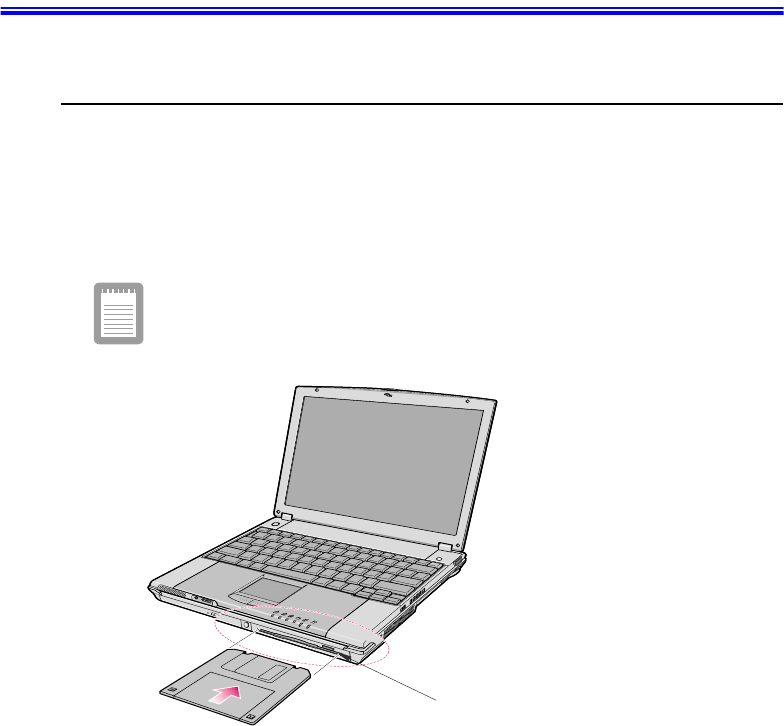
32 Using the Disk Drives
Using the Disk Drives
Using the Floppy Drive (FDD)
Your computer comes with a 1.44 MB, 3.5-inch, high-density floppy drive, which can
read, write to, and format the following disks:
•A high-density, 3.5-inch disk, which stores 1.44 MB (megabytes) of data.
•A double-density, 3.5-inch disk, which stores 720 KB (kilobytes) of data.
The floppy drive in your notebook computer is smaller, but more power-
efficient, than a floppy drive in a desktop computer. To get the best
performance from your floppy drive use high-quality floppy disks.
To use a floppy disk in your computer, insert it into the floppy drive (Figure 26).
Figure 26. Inserting a Floppy Disk
To remove a floppy disk, press the eject button on the floppy drive.
The floppy drive light on the computer is on when the computer writes to or reads from
a floppy disk. Do not remove a disk when this light is on.
To protect the data on your floppy disks, follow the manufacturers guidelines.
Floppy Eject Button

Using the Disk Drives 33
Using the CD/DVD-ROM Drive
Compact discs are designed so that you can easily insert one into the computer when
you need it, and then remove it.
1. Press the button on the CD-ROM drive, and the tray slides out. (Do not lean on the
tray; it does not support much weight.)
CD tray fails to slide out.
The tray may be stuck, in which case straighten out a paper clip, insert it into
the small hole in the front of the CD-ROM and push it until the tray ejects.
2. Insert a CD (compact disc), label side up (or remove a disc, if you have finished
using it).
3. Push the tray in gently to close the drive tray (Figure 27).
A light on the drive tray is on when the computer is reading from a CD. Do not
remove a disc when this light is on.
Figure 27. Using the CD/DVD-ROM Drive
Install and start a CD-based program as you would run a program on a floppy disk. See
your operating system documentation for more information on running programs.
The name of the CD/DVD-ROM drive is the letter following the letter assigned to your
last hard drive. For instance, if you have one hard drive with two hard drive partitions,
the hard drive is drives C: and D: and the CD-ROM drive is drive E.
Eject Button
CD/DVD-ROM Light
Emergency Eject Button
Emergency Eject Device

34 Using the Disk Drives
Proper CD Handling Techniques.
To clean a CD, wipe from the center outwards with clean and dry cloth.
Remove a CD when CD-ROM drive activity light is off.
CD/DVD drive precautions.
Do not place reflective objects in the disc slot because of possible hazardous
laser emissions.
The laser beam used in this CD/DVD-ROM drive is harmful to the eyes. Do not
attempt to disassemble the CD-ROM drive. Refer servicing to your authorized
service center.
The on-board audio hardware and software of your computer enable the computer to
play audio compact discs. If you wish to do so, you can attach external speakers to the
Headphone jack.
To play an audio compact disc:
1. Insert a compact disc into your CD-ROM drive:
a. Press the button on the CD-ROM drive, and its tray slides out.
b. Insert a CD, label side up.
c. Push the tray in to close the drive tray. The Windows Media Player button
appears on the taskbar.
The disc begins to play.
A light on the drive tray is on when the computer plays a CD. Do not remove a
disc when this light is on.
2. To adjust the sound, press the following key combinations: <Fn+F7> decreases
volume, <Fn+F8> increases volume.
To remove the CD:
1. Click the Windows Media Player button on the Windows taskbar to open the
Windows Media Player window.
2. Click the Stop button in the Windows Media Player window.
3. Click the Eject button on the Windows Media Player window or press the button
on your CD-ROM drive. The drive tray opens and you can remove the disc from
the CD-ROM drive.
4. For more information on playing compact discs, see the Help menu in the Windows
Media Player window.

Using the Disk Drives 35
Using the DVD-ROM Drive
See ”Using the Multi-Bay Docking Station” on page 30 for information on installing
the DVD-ROM drive into the computer.
The DVD-ROM drive operates the same as the CD-ROM drive. The DVD-
ROM drive and the DVD Player is supported by Windows 98/2000/Me.
Your DVD-ROM drive will play DVD-ROM and CD-ROM discs.
Installing the DVD Player MPEG-2 Software
The DVD software CD containing the DVD Player MPEG-2 software is optional with
DVD-ROM drives.
1. Start Windows and insert the CD Labelled DVD Player into the DVD ROM Drive.
2. The Installation application will start automatically, so follow the on-screen
instructions to complete the installation.
3. Reboot the system.
4. Make sure that DMA access is enabled for the DVD Drive:
a. From "Control Panel" open the "System" icon.
b. Select the "Device Manager" tab.
c. Click the "Plus sign" beside the CD-ROM entry and select the DVD-ROM drive.
d. Click the "Properties" button and select the "Settings" tab.
e. Check the "DMA" check box.
f. Click"OK"andrestartthesystem.
For more information on playing MPEG-2 movies and discs, see the Help menu in the
DVD Player window.

36 Using the Hard Drive
Using the Hard Drive
Your computer includes a IDE (integrated drive electronics) hard drive. The IDE hard
drive can store the data and programs your computer uses. The drive plugs into a
connector on the system board.
Although the storage capacity of hard drives varies according to model, any hard drive
holds much more than a floppy disk does. Also, the computer reads and works with a
hard drive more rapidly than with a floppy disk.
Once information is saved on a hard drive, it remains there until it is overwritten. Hard
drive heads park automatically when you turn off your computer.
Hard Disk Precautions
The hard drive that comes with your computer has already been formatted. Do
not format the hard drive. Doing so destroys all data contained on the drive. If
you need to format a new drive, or want to erase all data on your existing hard
drive, refer to the manual for your operating system.
The drive in your computer maybe divided into partitions. The file allocation table
enables the partitions to locate files and directories.Your computer recognizes each
partition as a separate drive, for example, if a hard drive has two partitions, they could
be recognized as drive C and drive D.
Although Windows 98 can work with FAT-16 or FAT-32 (a32-bit file allocation
table), your computer has been supplied with FAT-32. Older software that you may
have (16-bit software) may require FAT-16 to run.
Windows 2000/Me can use FAT16, FAT32 and NTFS.
It is not possible to convert from FAT-32 or NTFS to FAT-16 without
reformatting your hard drive.

Multi Media Functions/Equipment 37
Multi Media Functions/Equipment
Media Player
You can play video and audio CD files with the Windows Media Player, as well as
watching TV, video and listening to the radio through internet. The on-board audio
hardware and software of your computer enable the computer to play audio compact
discs. If you wish to do so, you can attach external speakers to the Headphone jack.
To play an audio compact disc:
1. Insert a compact disc into your CD-ROM drive:
a. Press the button on the CD-ROM drive, and its tray slides out.
b. Insert a CD, label side up.
c. Push the tray in to close the drive tray. The Windows Media Player button
appears on the taskbar, the disc begins to play. If the disk does not play click on
the windows media player icon on the Windows task bar then navigate to the
CD drive using the file open menu.
A light on the drive tray is on when the computer plays a CD. Do not remove a
disc when this light is on.
2. To adjust the sound, press the following key combinations: <Fn+F7> decreases
volume, <Fn+F8> increases volume or you may use the volume slidebar on the
Windows Media Player.
To remove the CD:
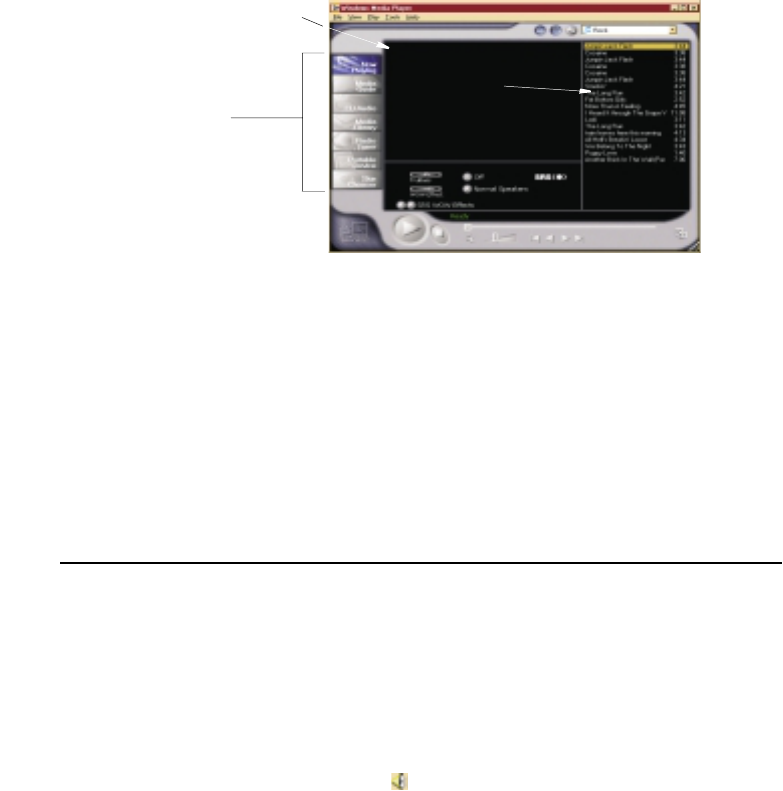
38 Multi Media Functions/Equipment
1. Click the Windows Media Player button on the Windows taskbar to open the
Windows Media Player window.
Figure 28. Windows Media Player
2. Click the Stop button in the Windows Media Player window.
3. Press the button on your CD-ROM drive. The drive tray opens and you can remove
the disc from the CD-ROM drive.
4. For more information on playing compact discs, see the Help menu in the Windows
Media Player window.
Double click Windows Media Player icon on the LCD display window.
Volume Control
Using the Keyboard
Changing the volume with your keyboard
Use <Fn> + <F7> to decrease the volume or <Fn> + <F8> to increase the volume.
Using the Volume Control Icon
Double click the volume control icon on a tray bar on down side of the LCD screen
and control volume in [Volume Control] as following window.
Using Windows Media Player
The Windows Media Player has a slidebar to adjust the volume, click and hold the
pointer on the slidebar and adjust the volume.
Display
Change Mode
Play List
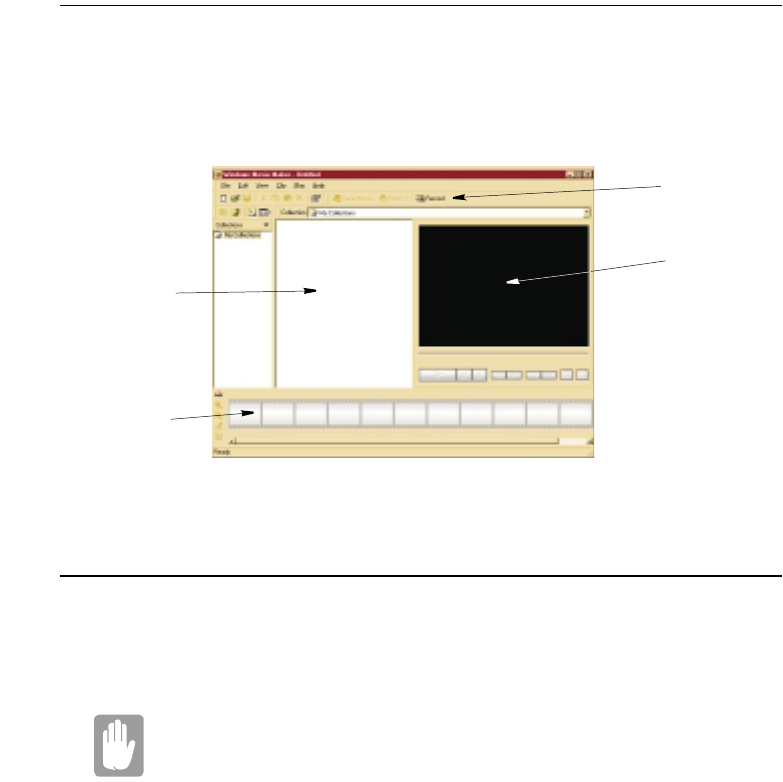
Multi Media Functions/Equipment 39
Movie Maker
You can edit audio and video data using this Movie Maker that is included with
WindowsMe. It is also possible to make a slide show with each frame or picture.
To start the program: Click Start > Programs > Accessories > Windows Movie Maker.
Figure 29. Windows Movie Maker
MP3 Player/Voice Recorder
Your system has MP3 player integrated inside the computer chassis. You can download
songs from internet and save them on your system flash memory, then you can listen to
the music even while the system is powered off.
The flash memory size of the MP3 Player is 32 MB, but the memory size
could be different from system to system.
Collections
Monitor
Workspace
Tool Bar
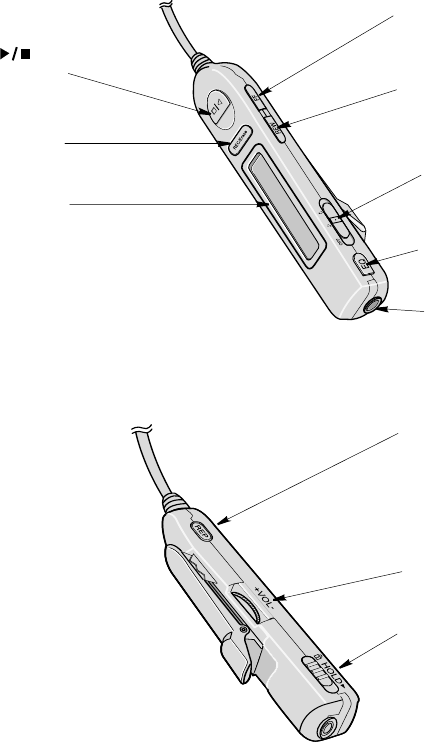
40 Multi Media Functions/Equipment
Figure 30. MP3 Player Top View
Figure 31. MP3 Player Bottom View
Listening MP3 file
To listen to your MP3 files simply follow the steps below.
1. Make a new folder on your system hard drive to store your MP3 files.
Play/Stop
FF (Forward)
Equalizer
Preset: Classic/Rock/Pop
REW (Rewind)
Power slide bar
Off/(1) Music/(2) Voice
Ear-phone connector
LCD
REC/Erase
REP (Repeat)
Repeat: repeat one MP3 file
All: repeat every MP3 file
Shuffle: mix the order of the file
VOL (Volume)
HOLD
Lock the MP3 remote controller
buttons except the Power slide bar.